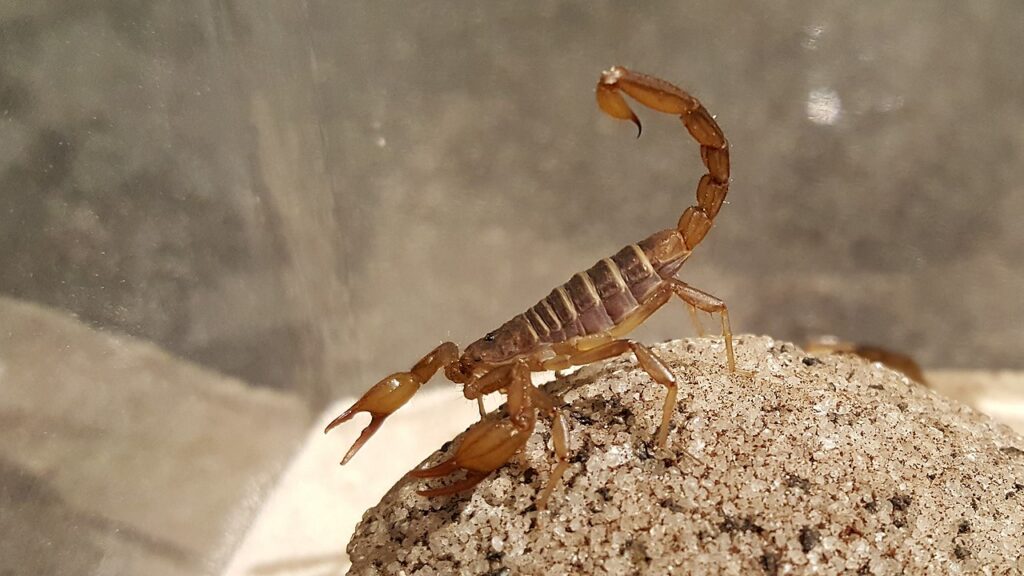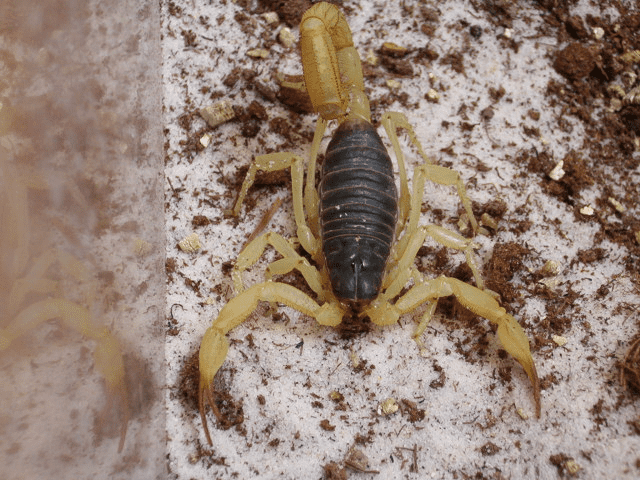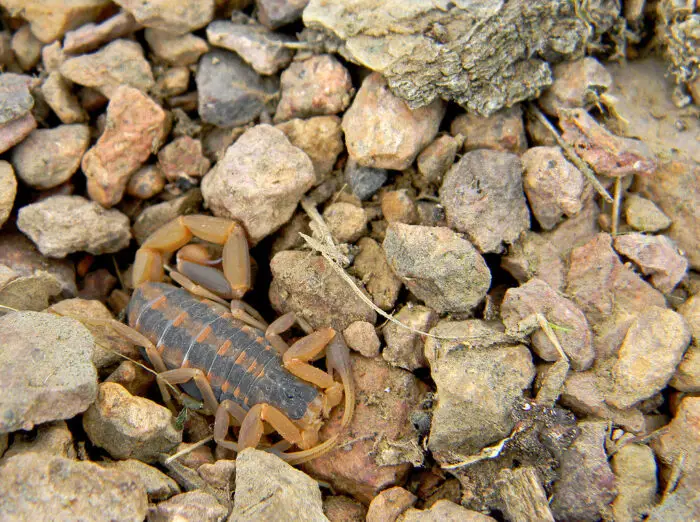There are three different species of scorpions in Colorado. They are the northern scorpion, (Paruroctonus boreus), the northern desert hairy scorpion, (Hadrurus arizonensis), and the common striped bark scorpion (Centruroides vittatus).
With their large pincers, scorpions look a little bit like tiny land-dwelling lobsters with some distinctions. Lobsters have 10 legs, while since they’re a member of the arachnid class, scorpions have 8, and of course, lobsters don’t have a bulbous venom-filled stinger on the end of their tail, while scorpions do.
In most cases, a sting from one of Colorado’s 3 types of scorpions will be no more medically significant than a bee sting. However, any scorpion sting or for that matter, any venomous sting carries the potential to cause severe allergic reactions in certain individuals. Severe reactions may include, blurred vision, difficulty swallowing, muscle twitching, and difficulty breathing. If you suffer from any of these symptoms after being stung by any species of scorpion, seek immediate medical attention.
Most scorpions glow under UV light. This is due to the fact that they have fluorescent compounds in their exoskeletons. If you are camping in an area where scorpions are active, it’s a good idea to go armed with an ultraviolet flashlight to scan your campsite after dark. Look here for a video made by Colorado Parks and Wildlife of a scorpion under black light.
Another group of tiny arachnids found in Colorado that are often mistaken for scorpions are pseudoscorpions. We will discuss them at the very end of the article.

Northern Scorpion (Paruroctonus boreus)
Northern scorpions live in 12 states in the United States. They also live in 3 Canadian provinces. The range of this species begins in northern Arizona and goes north into southwestern Canada. The U.S. states that have Northern Scorpions are Arizona, California, Nevada, Utah, Colorado, Idaho, Wyoming, Montana, North Dakota, South Dakota, Oregon, and Washington. In Canada, Northern Scorpions live in southern British Columbia, southern Alberta, and southern Saskatchewan. See, The furthest north that northern scorpions range is around 52 degrees north latitude. In Colorado, northern scorpions are present in the western counties, along the Utah border.
Northern scorpions have segmented sections in their exoskeletons that range in color from light brown to dark brown. What’s more, they have proportionately long tails with a stinger on the tip and two lobster-like front pinchers that do not function as legs. In size, an adult northern scorpion will be 35mm to 55mm (1.37 to 2.16 inches) long.
Northern scorpions rarely sting humans. What’s more, their venom has a relatively low toxicity. However, allergic reactions are a possibility with any venom. So even though they’re not one of the more dangerous scorpions, I still wouldn’t recommend keeping one in my sleeping bag or my hiking boot.
If you are camping in scorpion country, it’s a good idea to shake out your sleeping bag, clothes, and hiking boots before using them. It’s also a good idea to scan your camp after dark with ultraviolet light.

Northern Desert Hairy Scorpion (Hadrurus spadix)
The northern desert hairy scorpion is also known as the black back desert hairy scorpion.
The black back desert hairy scorpion is closely related to the giant hairy desert scorpion, (Hadrurus arizonensis), which is the largest scorpion in North America. Consequently, they are also quite large. They grow up to 5 1/2 inches long from their head to the tip of their tail. They are by far the largest scorpion found in the state of Colorado.
Their undersides, legs, claws, and tail are all yellow. The tops of their backs are black. This dark-colored back is one way to differentiate between them and the giant hairy desert scorpion.
Additionally, the tips of their claws are brown.
Another identifying characteristic that these scorpions have is that their bodies are covered with fine hairs.
These huge arachnids are burrowing scorpions. They take shelter in burrows that they excavate in the desert sand.
Northern desert hairy scorpions are the only Colorado scorpion species that are large enough to capture small rodents and lizards.
In Colorado, northern desert hairy scorpions are primarily found west of the continental divide. They are 1 of the scorpion species found in the Grand Junction area. They are also found along the Utah border. Such places as Dinosaur National Monument are within the range of these scorpions.

Common Striped Bark Scorpion (Centruroides vittatus)
Striped Bark scorpions are Buthid Scorpions, just as the Arizona Bark scorpion is. However, their sting is not nearly as dangerous as that of the Arizona Bark scorpion. Common striped bark scorpions are the most common species of scorpion in the United States. Thousands of people are stung by them each year when they step on them with bare feet or come into accidental contact with them in some other manner.
Unlike Northern scorpions and Northern Black Hairy scorpions, which never venture far from their burrows, Striped Bark scorpions are wandering hunters. Like all bark scorpions, they are natural climbers. Besides living under rocks, they climb trees, and fence posts, and have no problem climbing the walls of your home. They actually have a negative geotaxis, or in other words, they prefer an upside-down orientation. See,
Adult striped bark scorpions are up to 2 3/4″ long. An adult of this species is uniformly pale yellow in color, with the exception of two longitudinal dark stripes that run the length of its back.
In Colorado, common striped bark scorpions live in the southeastern part of the state. I-70 marks the northern extent of their range. See, These scorpions can potentially be in cities such as Denver and Colorado Springs, however, they are more prevalent the further south you go within the state.

Pseudoscorpions
There is a sub-species of pseudoscorpion that is exclusively native to Colorado. Their scientific name is (Cryptogreagris steinmanni). We’ll talk more about them in the last paragraph of this section. First though, let’s talk about what pseudoscorpions are.
Pseudoscorpions, which are also sometimes called book scorpions, or false scorpions are tiny members of the arachnid family. People often mistake them for tiny stingerless scorpions. This is due to the fact that they have prominent pincers or pedipalps just like scorpions do.
However, while a scorpion’s stinger is on the end of its tail, pseudoscorpions don’t even have tails. Instead of a tail with stinger pseudoscorpions have a very blunt-ended abdomen. They do have a venom-packed stinger in each pedipalp though.
Pseudoscorpions are actually more closely related to spiders than they are to scorpions. They spin silk, just as spiders do. They do this to make cocoon-like structures to take shelter in.
There are actually more than 3300 species of pseudoscorpion. The ones that you’re likely to find in your house are (Chelifer cancroides). These are the creatures that are also sometimes called book scorpions. Book scorpions are actually beneficial to humans. The reason being is that they prey on many a common pest such as fruit flies, mites and book lice.
A relatively newly discovered pseudoscorpion species called (Cryptogreagris steinmanni) was found in 2011 in some high-altitude caves near Glenwood Springs Colorado. See These pseudo scorpions are up to 1/2 inch (1.3-centimeters) long, which quite large compared to (Chelifer cancroides) which measure 0.098 to 0.17 inches (2.5 to 4.5 mm) in length.
Recent Posts
The only venomous snakes in Washington State are Northern Pacific Rattlesnakes. The Northern Pacific Rattlesnake (Crotalus oreganus oreganus) is a sub-species of the Western Rattlesnake. Anyone...
Skunks are not classified as true hibernators. But they go into a state of torpor when the weather gets cold. Skunks are light sleep hibernators, along with opossums, bears, and raccoons. ...
